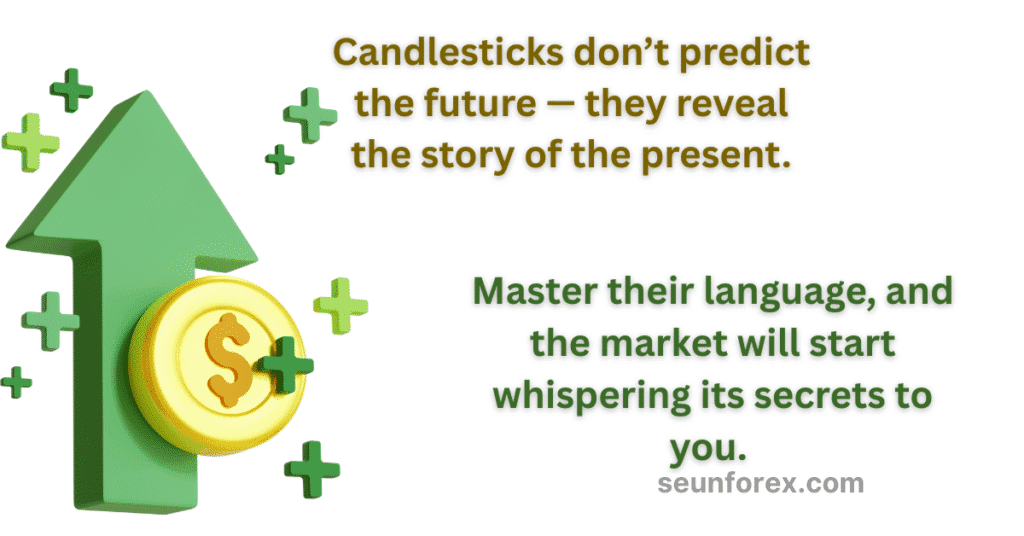
🔥 Introduction: The Illusion of Certainty
Candlestick patterns limitations are critical for traders to understand before risking capital. The room was silent except for the faint hum of the trading terminal. John’s eyes were glued to the EUR/USD 5-Of course. Here is the rewritten text, keeping the focus keywords intact and enhancing the narrative flow and impact.
The room was silent except for the faint hum of the trading terminal. John’s eyes were glued to the EUR/USD 5-minute chart as a hammer candle formed.
“Easy reversal,” he muttered, fist tightening.
Across the floor, Gordon barely glanced at the candle. His focus was on what he could control: risk management trading, market microstructure, liquidity, and timing. The candle was just a hint—a suggestion, not a guarantee.
This distinction highlights the critical candlestick patterns limitations every trader must grasp. Most novices chase patterns, believing the market speaks in simple signals. The truth is, the market is a complex ecosystem of orders, liquidity zones, and human behavior. While candlestick patterns provide context, they are meaningless without understanding trading psychology and proper risk management.
Context is everything. A hammer in a strong trend may signal continuation, not reversal. A doji in low volume is often just noise. Professionals like Gordon use patterns as clues, but their edge comes from position sizing, disciplined execution, and a deep understanding of market microstructure.
Candlestick patterns are tools for insight, not a prophecy of profit. Ultimately, mastering their limitations is what separates the amateur from the professional.
🧩 The Myth of Predictive Candlesticks
Novice traders often fall into the trap of pattern worship.
- They see a hammer candle and assume a bullish reversal.
- They spot a doji and panic about market indecision.
- An engulfing candle? Instant confidence.
Candlesticks are historical snapshots, not fortune-telling devices. They summarize what traders did in the past few minutes or hours — not what they will do next.
Psychologically, this illusion is powerful. Humans crave patterns. Our brains overfit data and perceive certainty where none exists. Emotional trading further amplifies the risk: fear of missing out, hope for a quick win, or panic over an unconfirmed signal.
Adding to this, the market is dynamic: liquidity, order flow, and news can all override what looks like a “perfect” candlestick pattern.
Example: A doji forms at a key support level. Beginner traders interpret it as indecision → they hesitate. But a liquidity sweep triggered by institutional traders can move the market past support before anyone reacts.
Candlestick patterns, therefore, are guides, not guarantees.
⚙️ Market Mechanics: Why Candles Aren’t Crystal Balls
To truly understand candlesticks, you need to understand market mechanics:
- Liquidity zones: Big players move the market to trigger stops and grab liquidity. Patterns can appear as traps rather than signals.
- Order flow: Candles reflect executed orders, not intentions. Large orders can distort a seemingly “perfect” reversal pattern.
- Volatility: A long wick might not indicate rejection; it might simply reflect a single large market participant moving the price.
According to Investopedia, candlestick patterns are “visual representations of price movements over a specified period.” They provide insights, but must be used with context and additional analysis.
Even the most “textbook” hammer or doji can fail. Without understanding market microstructure, your trade is essentially a guess.
🧠 Gordon vs. John, James & Robert: A Candlestick Story
It’s 10:03 AM. EUR/USD is trending sideways. A bullish engulfing pattern forms on the 1-hour chart.
- John jumps in immediately. “Pattern confirmed! Buy!” His stop is tight, but emotions are high.
- James sees the same candle, but over-leverages, convinced it’s a reversal.
- Robert hesitates, unsure, flips a coin, and buys half-size.
- Gordon does nothing… yet.
Gordon checks:
- Is the engulfing pattern forming near key support or resistance?
- Are liquidity zones crowded?
- What’s the risk-reward ratio?
- Is volume confirming the move?
Minutes later, a liquidity sweep hits the market. John’s position is stopped out. James panics and closes at a loss. Robert watches, frozen. Gordon? Calmly enters a position after confirmation, risking 2% to gain 6%.
Lesson: Candlestick patterns are suggestions. The discipline of risk management, understanding liquidity, and observing market behavior separates winners from pattern addicts.
Professional traders like Gordon see candles as conversation starters, not commands. A candlestick alerts him to a potential setup; confirmation is required from multiple layers: order flow, trend strength, volume, and macro events.
🔄 The Psychology of Confirmation Bias
Traders interpret candles through hope, fear, or overconfidence:
- Seeing a bullish candle, they convince themselves the trend is unstoppable.
- Spotting a bearish doji, they panic and exit prematurely.
- They selectively remember wins, ignore losses — reinforcing false confidence.
Confirmation bias leads to pattern over-reliance, which is why discipline and context are crucial. Candlestick patterns should be viewed like clues in a puzzle, not the puzzle itself.
Professional traders integrate risk controls: stop-loss placement, position sizing, and liquidity awareness. The novice reacts emotionally; the professional observes rationally.
🛠️ Step-by-Step: Using Candlesticks Correctly

- Context First: Identify trend, support/resistance, liquidity zones.
- Confirm with Volume & Structure: Candles alone aren’t enough.
- Risk Management: Set stops based on volatility, not emotion.
- Trade Small, Observe Reactions: Test patterns before committing.
- Journal Every Trade: Track pattern reliability over time.
- Observe Multiple Timeframes: A candle on a 5-min chart may be meaningless if the 1-hour chart shows a strong trend.
- Integrate Market News: Candlestick patterns can be invalidated by news events.
For disciplined execution strategies, see:
🔗 Liquidity Grab Myth: Trading Psychology & Risk Management
📈 Compounding Knowledge & Discipline
Candlestick mastery isn’t about instant wins. Gordon knows:
- Small, consistent gains compound faster than chasing patterns.
- Observing market psychology beats blindly following textbook candles.
- Risk-adjusted strategies ensure longevity.
Even if a pattern “fails” once, the lesson compounds: understanding why it failed, what the liquidity environment was, and how human behavior interacted with the market.
🔥 Deep Dive: Major Candlestick Patterns & Their Pitfalls
Even seasoned traders respect the power and limits of candlestick patterns. Let’s examine some of the most famous patterns and why relying solely on them can be dangerous.
1️⃣ Hammer & Inverted Hammer
- Appearance: Small body at the top, long lower wick. Suggests potential bullish reversal.
- Reality Check: If formed in low-volume sideways markets, the hammer can fail. Often a liquidity grab by large players sweeps weak hands before the real move begins.
- Lesson: Confirmation from trend context, volume, and risk-reward analysis is essential.
2️⃣ Shooting Star
- Appearance: Small body at the bottom, long upper wick. Indicates possible bearish reversal.
- Trader Trap: Beginners often sell immediately. Without understanding market microstructure, they may exit just as momentum continues upward.
3️⃣ Engulfing Patterns
- Appearance: A larger candle fully engulfs the previous one.
- Misconception: Seen as a guaranteed reversal signal.
- Reality: Works best near key support/resistance or after liquidity tests. Alone, it’s a suggestion, not a guarantee.
4️⃣ Doji Candles
- Appearance: Open and close are almost identical; indecision in the market.
- Trap: Traders overreact to dojis, fearing sudden reversals.
- Best Use: Observe alongside volume, trend, and liquidity.
🧠 Trader Psychology in Candlestick Interpretation
The market is a mirror of human emotion. Candlestick patterns reflect what traders did, not what they will do.
- John: Sees a hammer → buys impulsively → stops out.
- James: Spots an engulfing pattern → overleverages → panics when liquidity sweeps occur.
- Robert: Hesitates → misses low-risk entries.
- Gordon: Analyzes context → waits for confirmation → enters only when risk-reward is favorable.
Candlestick mastery is about mental discipline, not memorizing patterns.
⚙️ Step-by-Step Candlestick Strategy for Disciplined Traders
- Contextual Awareness: Identify trend, market structure, and key levels.
- Volume Confirmation: Candles without volume are often traps.
- Liquidity Observation: Large players trigger sweeps; anticipate them.
- Risk-Reward Calculation: Only enter trades with favorable ratios (1:2 or higher).
- Journaling: Track pattern reliability in real-market conditions.
For traders struggling with indecision or impulsive reactions, mastering this compounding mindset is essential. Internal strategies for disciplined execution are outlined here:
🔗 Liquidity Grab Myth: Trading Psychology & Risk Management
💡 Combining Candlestick Patterns with Market Microstructure
Understanding market microstructure improves candlestick interpretation:
- Order flow: Determines actual buying/selling pressure.
- Liquidity zones: Candles can be manipulated in low-liquidity regions.
- Volume spikes: Confirm genuine moves versus traps.
According to Bookmap, market microstructure knowledge allows traders to interpret patterns with context, reducing reliance on guesswork.
Candlestick patterns + microstructure insight + trading psychology = real edge.
🖼️ Canva & Pinterest Image Ideas
- Cracked Candle Illustration: A hammer candle cracking like a trap, showing “suggestion, not guarantee.”
- Alt Text: Trader analyzing hammer candle near liquidity zones, avoiding impulsive mistakes.
- Pinterest SEO Title: Trading Psychology: Candlestick Patterns as Suggestions, Not Guarantees
- Gordon vs. John/James/Robert Chart: Visual representation of traders’ reactions to the same candle.
- Alt Text: Disciplined vs. impulsive traders reacting to bullish engulfing candle.
- Step-by-Step Candlestick Strategy Graphic: Context → Volume → Liquidity → Risk-Reward → Journal.
🏆 Final Takeaways
- Candlestick patterns suggest possibilities, not certainties.
- Combine patterns with market context, volume, liquidity, and risk management.
- Discipline, psychology, and patience > chasing “perfect” candles.
- Internalize lessons from each trade to compound knowledge and capital.
- The “Holy Grail” is your process, not the candle.
Remember: Candlestick patterns are your guide — your discipline is your edge.